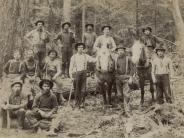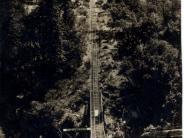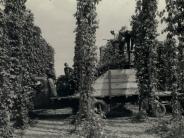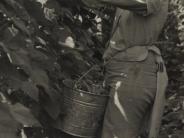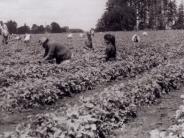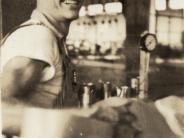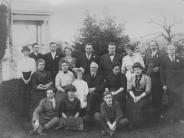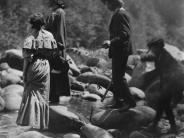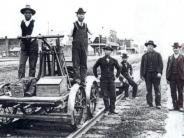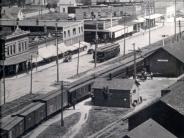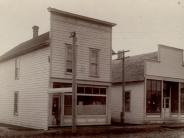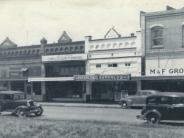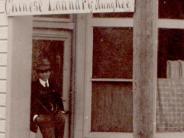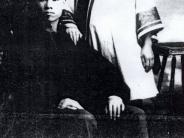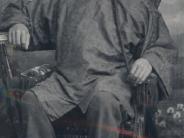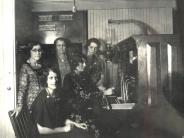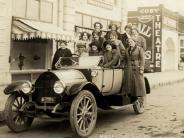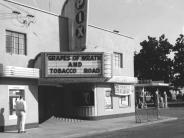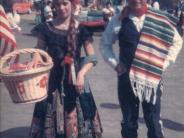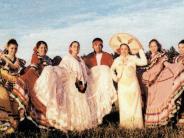Woodburn History
Prehistory
The history of Woodburn and the Willamette Valley goes far back before the places had names and people lived in the area. In the Woodburn Museum, the earliest items are from the Pleistocene epoch. During this time, the Willamette Valley was a wetter and colder place inhabited by giant sloths, ancient bison, and massive Teratorns - a large bird with a 14-foot wingspan - which roamed the valley along with animals we can still find here today.
Kalapuya
The first archaeological record of humans in the Northwest appears at the end of the Pleistocene epoch, at least 12,000 years ago and were most likely in North America starting 16,000 years ago.
According to the Oregon History Project, before 1750, the Pacific Northwest was home to around 200,000 people who spoke more than sixty distinct languages including Kalapuyan, Siuslawan, Malala, Takelman, and Kalamath-Modoc.
Today, the name Kalapuya is used to refer to the many bands and tribes that lived and live in the Willamette and Umpqua Valleys. The Kalapuya are made up of multiple bands who spoke three closely related languages and most likely would have been able to understand each distinct language because of their similarities. The three languages were Northern Kalapuya (or Tualatin-Yamhill), Central Kalapuya (or Santiam-Marys River (Chenapinefu)), and Southern Kalapuya (or Yoncalla). Of the many bands living in the Willamette Valley, the Kalapuya Ahantchuyuk who lived along the Pudding and Molalla rivers are most likely the band who lived where the city of Woodburn stands today.
By 1855, many groups were pressured to sign The Willamette Valley Treaty also known as The Treaty with the Kalapuya Etc. which was signed on January 22 and ratified on March 3rd, 1855. After this, many of the indigenous people were removed from their ancestral homelands to temporary reservations in Umpqua, Table Rock, and Willamette Valley and later to the Grande Ronde Reservation which today makes up one of nine federally recognized tribes in Oregon.
To learn more about the indigenous history of Oregon and about the indigenous people who live and lived in your area, Native Land Digital is one online resource which provides an interactive map where you can pinpoint your area and follow the links provided to learn more about the history and current information on the indigenous people where you live. Disclaimer: The Native Land map does not represent or intend to represent official or legal boundaries of any indigenous nations.
Also, explore the following links that were used as resources here.
The First Peoples - Oregon History Project
A Changing Landscape and the Beginnings of White Settlement - Oregon History Project
The Willamette Valley Treaty - The Quartux Journal
Settlers in Early Oregon
Between the 1860s through the 1870s, the population of settlers in Oregon increased from 52,465 to 90,923 with many of these people choosing to settle in the agriculturally abundant Willamette Valley.
In 1862, Jesse Settlemier moved from Mt. Angel to what would become Woodburn, acquiring 214 acres which he platted in 1872. Settlemier’s motivation for the creation of Woodburn was to get the railway to stop at the city. The Southern Pacific Railway only created stops if there was a city of a certain size making it a profitable stop. Settlemier encouraged the railway to build through and stop in Woodburn not only by creating the town but also by donating land to the railway for the construction of the tracks. In 1880, Southern Pacific built a warehouse in town and five years later they added a water tank and windmill. If you are interested in learning more about early railways, the following link expands on the railroad race in Oregon.
Railroads Race and the Transformation of Oregon - Oregon Historical Project
The railroad construction in Oregon began in the 1860s bringing with it many Chinese immigrants looking for ways to make a living, with many of them sending their wages back to their families and villages in China. In the 1800’s the majority of Chinese immigrants that settled in Oregon were from Taishan County in the Guangdong province, China. They came looking for a better life due to drought, famine and overpopulation in that region of China. Many found work with the railroad, as well as in logging and mining camps, and at the same time many settled in towns throughout Oregon including Woodburn where there were two Chinese laundries, one from 1890 and one in 1891. Little to none is known about the Chinese residents of early Woodburn except for a few photos and lists of city businesses. According to the Oregon Historical Project, in Oregon, the Chinese population grew from 425 to 9,540 from 1860 to 1890, making it the second-largest Chinese population in the United States at the time. If you would like to learn more about Chinese Americans in Oregon, explore the following links to the Oregon Historical Society and the Oregon Chinese Diaspora Project.
Oregon Chinese Diaspora Project
Chinese Americans in Oregon - Oregon Encyclopedia
Early on, the town was called Halsey but by the time it was incorporated in 1889, the city was known as Woodburn, supposedly inspired by a large fire in a nearby woodlot which occurred in the 1880s. After this, the town grew substantially. Within its first five years, the town records show the city grew to include many businesses such as groceries, dry goods stores, harness shops, telegraph offices, confectioners shops, churches, tailors, laundries and many more.
Since the Willamette Valley provided such good land for farming, many people were happy to settle in Woodburn. Through prosperous cane berry fields, Woodburn crowned itself as the ‘Berry Center of the World’ in 1923. If you explore our online photo collection you can find many images of people working in the fields picking marionberries, strawberries, pole beans, hops and for a short time even tobacco. Between 1905 to 1915 and 1922 to 1943, Oregon was the largest producer of hops in the country. The Willamette Valley continues to be known for its great growing conditions for farming and gardening to this day.
Hop Industry - Oregon Encyclopedia
Bracero Program - 1942
During the 1940s many Latinos came to Woodburn through the Bracero program. This program was implemented as a response to needs created by WWII (1939 - 1945). As a result of the war, many of the men who would normally be working in the fields to ensure food production, were enlisted. In Oregon, the Bracero program lasted from 1942 to 1947 and during that time, many of the Latinos who came as temporary workers decided to stay and make Woodburn their home. As a result, today, 95% of our city center businesses are Latino-owned and operated. You can find additional information about the Braceros program in the following links:
Bracero Program - Library of Congress
Bracero Program - Oregon Encyclopedia
Russian Old Believers - 1960s
The Russian Old Believers began to settle in Woodburn in the 1960s after three hundred years of fleeing persecution starting in 1654 after their schism with the Russian Orthodox Church after which they first fled from Russia to China and Turkey. In the 1950’s those in China, finding themselves under threat again, uprooted themselves to South America where they settled in Brazil, Bolivia and Argentina but found life there very hard and continued their search for a new home. When it became known that Woodburn and the surrounding Willamette Valley had good affordable farmland, a move to Woodburn began in the groups from China now living in South America, known as Harbintsy and Sinziantsy, and the group that settled in Turkey, known as Turchany. ‘The Old Believers in Woodburn have found a home in the Willamette Valley and to this day have preserved the practices and traditions they were persecuted for and caused them to flee Russia more than three hundred years ago.
Woodburn Museum and Bungalow Theater
The building where the Woodburn Museum and Bungalow Theater are today was first constructed in 1894, in Woodburn’s earliest days and have had many different lives, before becoming what they are today.
Since the early 1900s, theaters have been a part of the City of Woodburn. The Bungalow Theater which is attached to the Woodburn Museum has roots back to 1914, if not a little earlier. The theater provided the citizens of Woodburn entertainment for nearly fifty years before being closed after the opening of the newer and bigger Pix theater in 1949 which belonged to the same owner, Irvin Westenkow. After this, the theater was used for many different businesses until it was purchased in 1991 by the group that opened the museum in 1986. Along with the museum, they were interested in preserving the Bungalow theater for its historic value. It was reopened and after the closure of the Pix and the local Drive-in theater in the 1990s, it remains the only theater in town.
Today the theater has been restored and updated, retaining some of its old-time charm with updated seats and projector system. As a result of the restoration, the Woodburn Museum and Bungalow Theater received the Bricks and Mortar Award from the Oregon Main Street program as well as the DeMuro Award from Restore Oregon, for preserving an important piece of Oregon and Woodburn history. In the lobby, visitors can see one of the old film projectors and chairs from the old theaters, which nods to its long history here in Woodburn.
The museum was founded in 1986 by a group of citizens passionate about preserving the heritage of Woodburn. The founding of the museum took place as the City was preparing for its 100th Anniversary Celebration which was held in 1989, marking the Incorporation of Woodburn as a city 100 years before.
Some of the key volunteers were Red Eaden, Paul Graham, Vance Yoder, Lou Jane Cornwell, Gene Stoller, Paul Serres, Tom Pantle, Gail Wengenroth, Kathy Figley, Ed Murphy, Nevin Holly, Hazel Smith and Nancy Kirksey, who was Mayor of Woodburn from 1986 - 1990.
The group turned a former hardware store, plus the adjoining historic Bungalow Theater, into a tribute to Woodburn’s heritage. In 2000, the City of Woodburn became the steward of the museum, managing it and the theater with the support of many local volunteers. Today the museum covers the history of Woodburn from prehistoric, through to the present-day community in Woodburn.
For more Oregon history check out the Oregon Encyclopedia.

